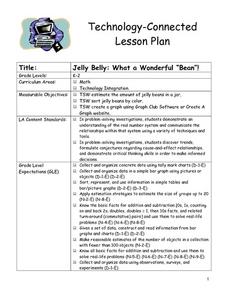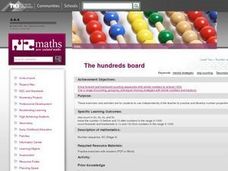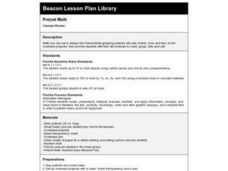Curated OER
Rounding Numbers
In this rounding numbers worksheet, students, with a partner, problem solve and calculate the answers to eighteen mathematical exercises.
Curated OER
Use Symbols to Subtract
Students practice crossing out items in a group in order to complete subtraction problems. In this subtraction lesson plan, students watch a PowerPoint presentation and then practice problems on their own.
Curated OER
Elements
In this elements activity, students write the electron configurations for given elements. Students describe ionization energy and electron affinity and the periodic trends for both. This activity has 20 short answer questions.
Curated OER
Telling Time to 5 Minutes
Young scholars take part in various activities ranging from creating a human clock, to small group problem solving to reinforce the concept of telling time accurately to five minutes on an analog clock.
Curated OER
Significant Figures and Measurement
In this science learning exercise, students draw several markings on a ruler or graduated cylinder or thermometer to get each of the correct measurements. Then they state what place the marking indicates and the number of significant...
Curated OER
Tell Answer Of The Questions: Place Value 7
In this online interactive place value worksheet, students respond to 1 question that requires them to identify the numeral in the 10's place in a 3-digit number. Students submit their answers to be scored.
Curated OER
Jelly Belly: What a Wonderful "Bean"!
Students explore how jelly beans are produced. They discuss the origins of the jelly bean and view a video about how jelly beans are prepared, tested, shaped, finished, and shipped and estimate the amount of jelly beans in a jar and sort...
Curated OER
Addition Strategies: Compensation
In this math worksheet, students learn the addition strategy of compensation: adding an easy number like 10, 20 or 30 and then subtracting a very small number like 1 or 2. Students solve 12 problems on the page.
Curated OER
Stretch to the Math Tables
Learners count by multiples while performing stretches or exercises. They listen to music and skip count by a given multiple. The rhythm of the music as well as the repitition assists them in their memorization of multiplication facts.
Curated OER
Money
Second graders show combinations for $1.00. In this dollar combinations lesson, 2nd graders use nickels, dimes, and quarters to model and count combinations equaling $1.00.
Curated OER
Money for starters
Students compare the values of coins and paper money. They read prices, read and write any 2-digit number. They model and explain addition calculations with a sum of up to 20.
Curated OER
The Hundreds Board
Pupils explore the concept of multiples and use a hundreds board to add numbers and then graph them. Afterward, they use the sieve of Eratosthenes to identify prime numbers and discover how numbers change when you add or subtract by ten.
Curated OER
Mice are Nice 80
Students complete a variety of mouse-themed activities. They listen to stories, recite poetry, identify rhyming words, write sentences, create art projects, take a survey and design an original mousetrap.
Curated OER
Pretzel Math
Students demonstrate grouping pretzels into twos, fives and tens, then eat their groups of pretzels! After a lecture/demo, students work in groups practicing the proper grouping.
Curated OER
Places, Places, Everyone
First graders play the game Show Me and use math software to practice place value.
Curated OER
Math -- Money
Students identify a penny, nickel, dime, quarter and a half dollar. They examine the value of each coin and its equivalents (to quarter/dollar). After pairing up with a classmate, each one drills the other one on each coin.
Alabama Learning Exchange
Money Management
Learners discuss the differences between needs and wants, practice budgeting resources and investigate the workings of a capitalist society, by creating a mock store.
Curated OER
Subtraction Shopping
Students subtract two digit numbers. They check each other's answers for accuracy.
Other
Nearpod: Skip Counting by 5s, 10s, 100s:
For this lesson, students will learn how to skip count by 5s, 10s, and 100s.
Better Lesson
Better Lesson: Multiply and Divide by 10
Counting by 10's is easy for students of this age. Knowing that base 10 can be used to help multiply and divide in the higher numbers by decomposing is critical. This lesson sets the base for future work.
Better Lesson
Better Lesson: Using a Pattern to Solve a Problem
Patterns are prevalent in all levels of math. Common Core Standards expect students to be able to use structure - like that found in repeating the patterns of odd and even numbers or counting by 5s or 10s - to solve problems (MP7).


















